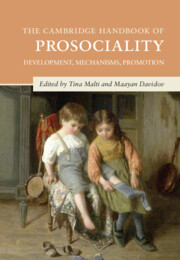Book contents
- The Cambridge Handbook of Prosociality
- Cambridge Handbooks in Psychology
- The Cambridge Handbook of Prosociality
- Copyright page
- Dedication
- Contents
- Figures
- Contributors
- Part I Development of Prosociality
- Part II Antecedents and Mechanisms of Prosociality
- 11 The Motives of Prosocial Behavior
- 12 Morality, Values, and Prosociality across Development
- 13 Emotions and Prosociality
- 14 Social-Cognitive Development and Early Prosocial Behavior
- 15 Temperament and Prosocial Behavior
- 16 Gender and Prosocial Development
- 17 Assessing Prosociality
- Part III Development of Prosociality in Context
- Part IV Applications
- Index
- References
11 - The Motives of Prosocial Behavior
from Part II - Antecedents and Mechanisms of Prosociality
Published online by Cambridge University Press: 25 May 2023
- The Cambridge Handbook of Prosociality
- Cambridge Handbooks in Psychology
- The Cambridge Handbook of Prosociality
- Copyright page
- Dedication
- Contents
- Figures
- Contributors
- Part I Development of Prosociality
- Part II Antecedents and Mechanisms of Prosociality
- 11 The Motives of Prosocial Behavior
- 12 Morality, Values, and Prosociality across Development
- 13 Emotions and Prosociality
- 14 Social-Cognitive Development and Early Prosocial Behavior
- 15 Temperament and Prosocial Behavior
- 16 Gender and Prosocial Development
- 17 Assessing Prosociality
- Part III Development of Prosociality in Context
- Part IV Applications
- Index
- References
Summary
This chapter describes the development of prosocial motives and the social contexts within which these motives emerge and differentiate. Initially, prosocial behavior is based on a blend of motives, namely, participating in social interaction and early forms of feeling for others. During early childhood, concern-based guilt emerges and mere participation transforms into contributing to collaborative activities. During childhood, the normative turn complements these motives by a sense of obligation (living up to), and, during adolescence, aspiring to one’s ideal self can become an important prosocial motive. In this sense, doing good often is an expression of central human motives, namely, belonging to others, feeling for others, contributing to joint endeavors, affirming a sense of responsibility and normative obligation, and striving for our ideal selves.
Keywords
- Type
- Chapter
- Information
- The Cambridge Handbook of ProsocialityDevelopment, Mechanisms, Promotion, pp. 209 - 232Publisher: Cambridge University PressPrint publication year: 2023
References
- 1
- Cited by



